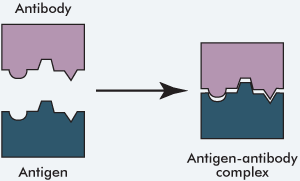Introduction
Phagocytosis
Humoral response
Cell-mediated response
Common flu
Vaccinations
Introduction
Different cells have different molecules presented on their surface to the immune system. These are often protein-based and enable the identification of:
–pathogens
-cells from other organisms of the same species
-abnormal body cells
-toxins
The specific immune response is split into humoral immunity and cell-mediated immunity. Humoral is to do with the blood and antibodies. Distinguishing between an antigen and an antibody is very important.
Antigen = protein or carbohydrate foreign (not normally present) to a host’s organism.
Antibody = protein made as a response to detecting an antigen which binds to the antigen and prevents the pathogen from harming the host.

Immunity against invading pathogens is a crucial part of maintaining health. The body has adaptations which prevent invasion by pathogens, as well as processes in place to deal with those that manage to penetrate the body’s primary defences. The skin and mucous membranes (e.g. mouth) are examples of such defences. Sweat contains lysozyme which is an enzyme that breaks down bacterial walls.
If pathogens do invade the body, the subsequent immune response is split between:
Non-specific
Specific
The non-specific immune response is inflammation and phagocytosis.
Phagocytosis
White cells (the most common ones are neutrophils) engulf any foreign particles such as dust or bacteria, then digest them and dispose…
